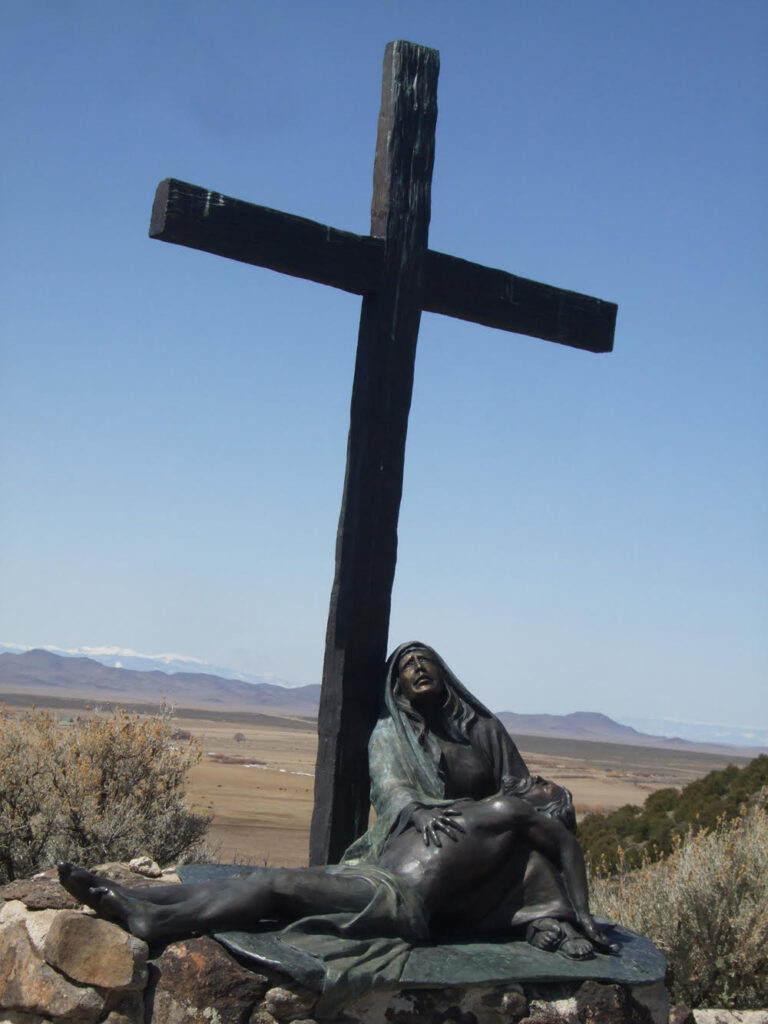If you have, say, four hours, good weather and a full tank of gas, you might plan a trip from Denver to Colorado’s oldest town. Beginning now and over the next few weeks, visitors will be making the trip and not just travelers from Denver. It’s the beginning of the Holy Season and a trip to San Luis and stop at The Stations of the Cross are annual pilgrimages for Catholics and a lot of others.
Today is Ash Wednesday and San Luis will be getting more than its normal share of visitors. Many, if not most, will be parking next to the town’s visitor center and crossing the street to the town’s best known and most visited site.

The Stations of the Cross, La Mesa de la Piedad y de la Misericordia—Hill of Piety and Mercy—are a monument that detail the final hours in the life of Jesus Christ. The fifteen stations begin with His condemnation, ending not quite a mile later and several hundred feet higher with His crucifixion. Each of the bronze works of art are scaled at approximately three quarters to life-sized and the creation of local artist Humberto Maestas.
A first edition, smaller scaled version of Maestas work—maquettes—is part of the Vatican Museum’s permanent collection in Rome.
Despite being a Colorado native, this is the first year that Father John Farley will be in San Luis for the Holy Season as the shepherd of the town’s Sangre de Cristo Catholic Church. In a recent telephone interview, he talked about his first visit there as a young seminarian and the way he sees them today.
“I was just overwhelmed,” he said. But ‘overwhelmed,’ despite its power, said the Pueblo native, falls short of the raw emotion the shrine elicits. On subsequent visits he’s made from the church to the Stations, he said he’s come to appreciate just how special and inspiring the Stations are, especially, for him, one particular station.

“I was definitely drawn into the wonder and drama of each of the monuments. And for whatever reason, Station 13, when they take Jesus down the cross reaches deep into me.” Station 13 is a life-like sculpture of a Jesus who has been taken off the cross and is now in the arms of his mother.
With the pandemic now under a degree of control that may have been thought impossible just a year or so before, the priest of the Valley thinks people will be making the trek to San Luis to satisfy a spiritual appetite. “People are hungry for connection and the peace they feel along the way.”
Each of the Stations is adorned with a bronze plaque that has a biblical parable on the final hours in Christ’s life, from judgment to resurrection. There is no charge to visit the site, but donations are often given at the top of the visitor center or at the Sangre de Cristo Church.
Visits to the Stations during the Lenten season, Farley suspects, will increase. But he also said that between now and Easter, April 9th, Fridays will likely see the most traffic at the Stations. Still, as a newcomer to the Valley, he has wondered why the town, most of which shares the Catholic faith, has not made more use of the Stations for religious observances. “I’ve been asking that question, trying to find out what has been the general practice and there doesn’t seem to be a tradition.”
Faith has played an enormous role in the Valley since its earliest days of settlement by Spanish, Mexican and Native people. The Stations, sometimes referred to as ‘Calvary in Colorado,’ reflect both its depth and heritage. The Stations, said Father Farley, are the simplest confirmation.
“For me, it is more about handing it over and giving it (oneself) up,” he said. “This has a far more different feeling than a morning offering…both peaceful and powerful.”





